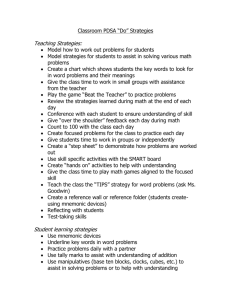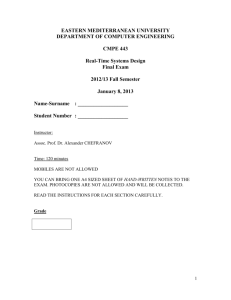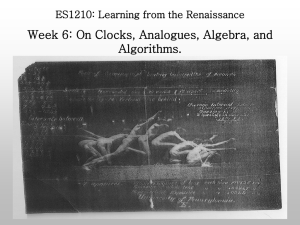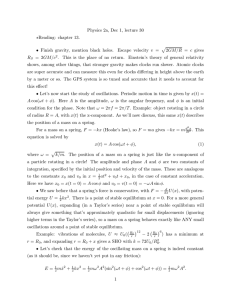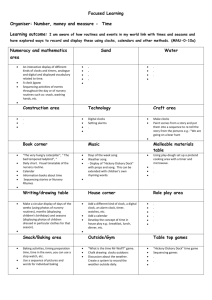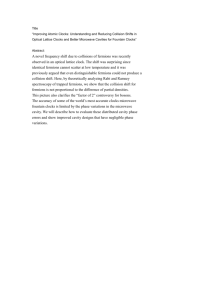Clocks Observations About Clocks
advertisement
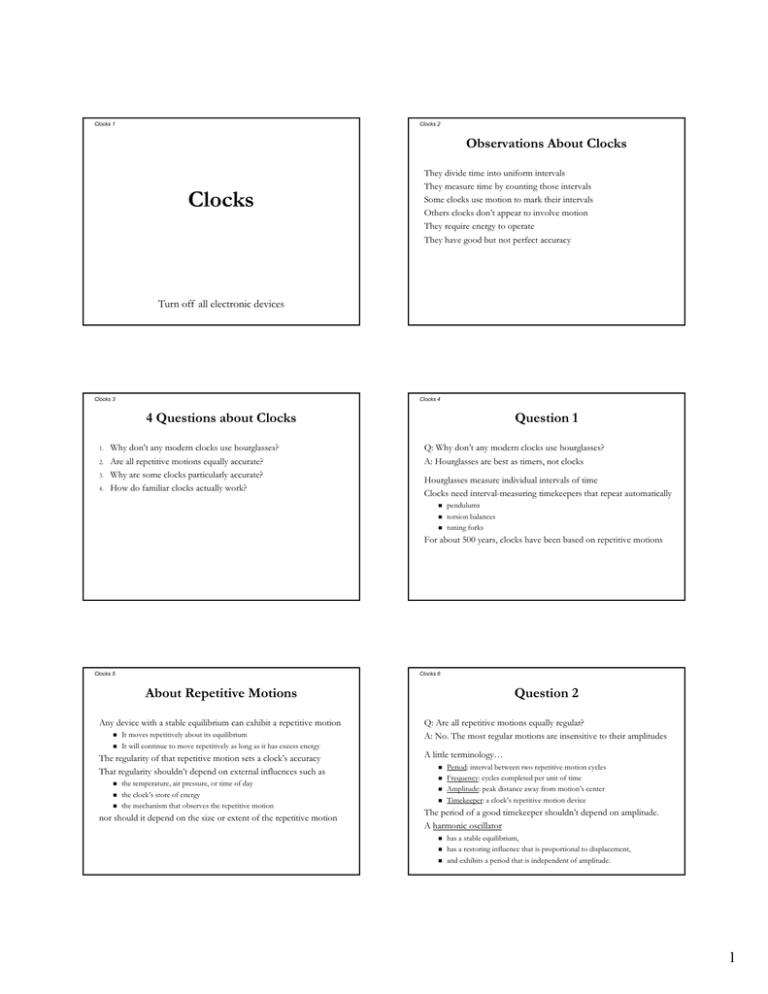
Clocks 1 Clocks 2 Observations About Clocks Clocks They divide time into uniform intervals They measure time by counting those intervals Some clocks use motion to mark their intervals Others clocks don’t appear to involve motion They require energy to operate They have good but not perfect accuracy Turn off all electronic devices Clocks 3 Clocks 4 4 Questions about Clocks 1. 2. 3. 4. Why don’t any modern clocks use hourglasses? Are all repetitive motions equally accurate? Why are some clocks particularly accurate? How do familiar clocks actually work? Question 1 Q: Why don’t any modern clocks use hourglasses? A: Hourglasses are best as timers, not clocks Hourglasses measure individual intervals of time Clocks need interval-measuring timekeepers that repeat automatically pendulums torsion balances tuning forks For about 500 years, clocks have been based on repetitive motions Clocks 5 Clocks 6 About Repetitive Motions Question 2 Any device with a stable equilibrium can exhibit a repetitive motion Q: Are all repetitive motions equally regular? A: No. The most regular motions are insensitive to their amplitudes It moves repetitively about its equilibrium It will continue to move repetitively as long as it has excess energy The regularity of that repetitive motion sets a clock’s accuracy That regularity shouldn’t depend on external influences such as the temperature, air pressure, or time of day the clock’s store of energy the mechanism that observes the repetitive motion nor should it depend on the size or extent of the repetitive motion A little terminology… Period: interval between two repetitive motion cycles Frequency: cycles completed per unit of time Amplitude: peak distance away from motion’s center Timekeeper: a clock’s repetitive motion device The period of a good timekeeper shouldn’t depend on amplitude. A harmonic oscillator has a stable equilibrium, has a restoring influence that is proportional to displacement, and exhibits a period that is independent of amplitude. 1 Clocks 7 Clocks 8 Harmonic Oscillators Any harmonic oscillator has an inertial aspect (e.g., a mass) a spring-like restoring aspect (e.g., a spring). A harmonic oscillator’s period decreases as its inertial aspect becomes smaller its spring-like restoring aspect becomes stiffer Common harmonic oscillators include a mass on a spring a pendulum a flagpole a tuning fork Question 3 Q: Why are some clocks particularly accurate? A: They have especially well-designed harmonic oscillators Harmonic oscillator clocks have practical limits to accuracy Those clocks also have fundamental limits to accuracy Clocks 9 Q: How do familiar clocks actually work? A: Their harmonic oscillators are set in motion and observed carefully Common harmonic oscillators used in clocks are pendulums balance rings quartz crystals Each of these clocks has a harmonic oscillator as its timekeeper, supplies that harmonic oscillator with energy to keep it going, and counts cycles of that oscillator Clocks 11 Pendulum Clocks A pendulum is (almost) a harmonic oscillator For small displacements an inertial aspect (e.g., a mass) a spring-like restoring aspect (e.g., a spring). In most harmonic oscillators, those two aspects are independent However, a pendulum’s spring-like restoring force is proportional to the pendulum’s weight is therefore proportional to the pendulum’s mass Therefore, increasing a pendulum’s mass length is temperature stabilized length is adjusted for local gravity friction & air resistance are small motion is sustained and measured gently A pendulum clock mustn't be moved or tilted Clocks 12 Recall that any harmonic oscillator has Its restoring force is proportional to displacement Its period is independent of amplitude Its period is proportional to (length/gravity)1/2 For accuracy, the pendulum’s Pendulums as Harmonic Oscillators Rate at which oscillation wastes energy limits preciseness of its period Most accurate clocks waste as little energy as possible Clocks 10 Question 4 Sustaining the repetitive motion can influence its period Measuring the period itself can influence the period Temperature, pressure, wind… can influence the period Balance Ring Clocks Coil spring and balance ring form a harmonic oscillator Balance ring twists back and forth rhythmically Gravity exerts no torque about the ring’s pivot Gravity has no influence on the period For accuracy, balance ring’s friction & air resistance are small motion is sustained gently motion is measured gently increases its inertial aspect increases the stiffness of its restoring force aspect therefore has no effect on its period! 2 Clocks 14 Clocks 13 Quartz Clocks A quartz crystal is a harmonic oscillator The crystal’s mass provides the inertial aspect The crystal’s body provides the spring-like restoring aspect As a harmonic oscillator, a quartz crystal’s oscillation decay is extremely gradual sensitivity to gravity, temperature, and environment are minimal fundamental accuracy is extremely high Summary about Clocks Most clocks involve harmonic oscillators Amplitude independence aids accuracy Clock sustains and counts oscillations Oscillators that lose little energy work best Quartz is piezoelectric mechanical and electrical changes are coupled Its motion can cause electric effects Its electric situation can cause motion 3
